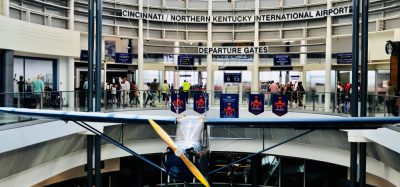World-class baggage handling operations
- Like
- Digg
- Del
- Tumblr
- VKontakte
- Buffer
- Love This
- Odnoklassniki
- Meneame
- Blogger
- Amazon
- Yahoo Mail
- Gmail
- AOL
- Newsvine
- HackerNews
- Evernote
- MySpace
- Mail.ru
- Viadeo
- Line
- Comments
- Yummly
- SMS
- Viber
- Telegram
- Subscribe
- Skype
- Facebook Messenger
- Kakao
- LiveJournal
- Yammer
- Edgar
- Fintel
- Mix
- Instapaper
- Copy Link
Posted: 28 March 2008 | Tebogo Mekgoe, Assistant General Manager, O.R. Tambo International Airport (ORTIA) | No comments yet
Considering that O.R. Tambo International Airport is fast gaining status as world class, it is no wonder that all the facilities and technologies available in the airport precinct compare with the best in the world. As the largest airport in Africa, currently processing over 18 million passengers annually, Airports Company South Africa (ACSA) have made certain that O.R. Tambo has a baggage handling system comparable with the best in the world.
Considering that O.R. Tambo International Airport is fast gaining status as world class, it is no wonder that all the facilities and technologies available in the airport precinct compare with the best in the world. As the largest airport in Africa, currently processing over 18 million passengers annually, Airports Company South Africa (ACSA) have made certain that O.R. Tambo has a baggage handling system comparable with the best in the world.
Overview
The baggage handling system at O.R. Tambo currently encompasses two main systems; the Domestic and International Departures Sortation Systems. It also includes two transfer conveyor systems, which connect the two terminals and allow transfer baggage to be processed for domestic, regional and onward international flights. The Systems were both installed by highly reputable European manufacturers, with the Domestic Sortation System being installed as recently as 2003.
Both of the baggage handling systems are fully automated and currently handle volumes of up to 3100 bags an hour. The system however, has been designed to handle much larger volumes as the airport grows in terms of passenger numbers.
On a monthly basis, O.R. Tambo handles an average of one million normal pieces of baggage, or in-gauge baggage, and a further 350,000 abnormal, or out-of-gauge baggage (bicycles, fragile items etc). In terms of arrivals, O.R. Tambo currently has seven international arrivals reclaim carousels and six smaller domestic carousels.
The system
ACSA has employed the use of the Tilt-Tray Sortation System at O.R. Tambo, a high-speed system, speeding up the general flow of baggage through the baggage handling system.
During the planning and design process of the fairly new system in the domestic terminal at O.R. Tambo, the point of departure was to find a system that integrated an automated baggage sortation system, able to meet critical airport and airline requirements. The tilt-tray system not only offered the much needed operational speed required in an airport of O.R. Tambo’s magnitude, but also provided the flexibility to be built as needed throughout airport property, including the underground at the airport’s domestic terminal building.
As managers of the airport, one of our top priorities is to ensure the safety of all the baggage passing through our system. With this in mind, we also employed a system which would give us the ability to uniquely identify and track-and-trace every individual item. The end result is a transport and sortation system that ensures the safe arrival of baggage to the right aircraft or terminal at the right time, expediting passenger travel even in the most time-critical schedules. An added advantage is that our system has the capability to accurately handle early bags, for the utmost in scheduling flexibility, should our airline stakeholders require it.
The process
Check-in
The baggage system begins at the check-in point, where each individual piece of checked-in luggage is weighed and then tagged for tracking and scanning. The IATA bar code is used for tracking purposes. Baggage is then dispatched onto one of the collect lines which merge into one of the transportation conveyors.
The collect lines can be reversed and merged onto adjacent lines as a means of redundancy, should the primary line be down for some reason, ensuring that operations are always up and running. This feature is largely unique to O.R. Tambo.
Tracking baggage allows the bags to be tacked at certain tracking points within the baggage system and also contains all necessary passenger information, including the flight number and ultimate destination.
Baggage conveyor system
Once baggage reaches the baggage conveyor system, the Baggage Reconciliation System (BRS) tracking immediately goes into use, with both airlines and ground handlers able to track baggage location. A significant part of this point in the baggage handling process, are the various levels of security a piece of luggage could potentially go through, in order to be deemed safe to be placed on board an aircraft.
Level 1 and 2 screening
All baggage is subject to the mandatory Level 1 automated in-line screening process, with Level 2 also forming part of the in-line screening process. Bags failing Level 1 will have the X-ray images transferred to Level 2 workstations, in a remote area, where specially trained operators make a decision to either pass baggage to continue on normal processing, or to send suspicious baggage on to Level 3 screening.
Level 3, 4 and 5 screening
Once baggage is elevated to Level 3 screening, it undergoes intense evaluation through further scanning methods. At this point, the bag either passes to go back onto the baggage system or is elevated to Level 4. At Level 4, the procedure is to reconcile the bag with the respective passenger before the bag is opened, to undertake a further security check.
If the bag poses an immediate threat or if the respective passenger cannot be located for Level 4 screening, the bag is immediately handed over to the South African Police Services and ACSA Security.
Baggage sortation system
As soon as baggage has been through the appropriate levels of security screening, baggage is automatically sorted in terms of respective flights and is transported to the appropriate chute. At this point in the process, any baggage located in the Early Baggage Store (EBS) will automatically be released into the system once the corresponding flight has opened. Conveyor lines in the EBS correspond to respective flights or chute opening times and once emptied, re-merge with the main baggage sortation system. We have made the provision for airlines to allow passengers to check-in early for their flights. This, we believe, contributes to a seamless experience at O.R. Tambo.
Chute
Once baggage has reached its respective chute, the baggage handling company, appointed by a respective airline, takes direct responsibility.
Baggage container
Baggage is immediately loaded into containers that are scanned and then secured prior to leaving the departure area for the aircraft.
Aircraft
Finally the baggage is loaded onto the aircraft, with all containers and loose bags also being scanned at this point.
Overseeing the process
A central baggage handling control room was put in place at O.R. Tambo during 2007, with the distinct purpose of giving ACSA the ability to tightly manage the operational effectiveness of the baggage handling environment at the airport. The advent of the control room allows us to watch over the baggage handling system live, giving us the advantage of acting almost immediately should any problem on the system, no matter how small, arise.
The control room makes use of the Supervisory Control and Data Aquisition system (SCADA), which essentially gives information regarding the status of the baggage handling system through a snapshot of both the areas at O.R. Tambo. Also fundamental, is that it goes a long way to ensuring certain performance indicators required for successful baggage handling systems.
The baggage handlers
As a large stakeholder with the baggage handling environment at O.R. Tambo, ramp handlers licensed to operate at the airport are closely managed by ACSA. In fact, at the beginning of March this year, two new licensed ramp handlers will start ground handling operations at ACSA’s airports. ACSA has put in place a comprehensive change management process to ensure a smooth transition and is working closely with the airlines, the new service providers and other relevant role players, to ensure that service delivery is not compromised during the transition period.
Both Menzies Aviation and BidAir Services are experienced ramp handlers. Menzies is an international ramp handling company, with operations in 107 stations worldwide, while BidAir is a South African company within the Bidvest group of companies. BidAir has a number of companies with relevant aviation experience, notably Commuter Handling Services (CHS) with 20 years of ramp handling experience. CHS currently operates under an ACSA issued self handling ramp license and provides services to Comair and Kulula.
The new license conditions signed by Menzies Aviation and BidAir Services compel them to further improve baggage delivery standards, as well as provide innovative and world class service delivery practices. They will be subject to a stringent service level agreement, which includes provision of secure, on-time baggage delivery, monitoring and supervision of passengers’ bags.
Looking ahead
As part of the general infrastructure development programme (and part in preparation for the 2010 Fifa World Cup), the international arrivals halls will, in the near future, house ten new carousels. These will include four new 90m carousels, specifically designed to handle the large volumes of the A380. In addition, three new carousels will be available in the new Central Terminal Building (CTB), with carousels in the domestic terminal also being lengthened.
The new system equipment currently being installed in the CTB and the baggage upgrade projects, has all been designed, supplied and commissioned by European manufacturers with decades of experience, as with the existing system. While we already have an extremely seamless baggage handling system in place, we expect our ability to handle baggage at a faster rate, with much larger volumes, to increase significantly once the new system, in addition to the upgrades, comes into operation. Our ultimate goal is to make the passenger experience hassle-free, and baggage processing plays a large part.
About the author
Tebogo joined Airports Company South Africa about eight years ago, where he began his career at O.R. Tambo International Airport in the Maintenance and Engineering Department. Four years later he joined the domestic airports team within ACSA as Airport Manager for East London Airport, in charge of all airport operations.
In 2007 Tebogo returned to O.R. Tambo as Assistant General Manager, where he is largely responsible for managing the airport’s operational effectiveness and optimisation, ensuring optimal usage of airport infrastructure and maintaining the highest level of safety & security standards at all times.
Tebogo holds a BSc Engineering degree from the University of Cape Town and a Post Graduate Diploma in Business Administration from Wits Business School. He has spent his entire professional career working for ACSA.
















